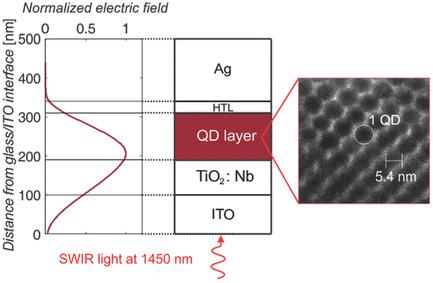当前位置:
X-MOL 学术
›
Adv. Funct. Mater.
›
论文详情
Our official English website, www.x-mol.net, welcomes your
feedback! (Note: you will need to create a separate account there.)
Optimization of Charge Carrier Extraction in Colloidal Quantum Dots Short‐Wave Infrared Photodiodes through Optical Engineering
Advanced Functional Materials ( IF 18.5 ) Pub Date : 2018-09-06 , DOI: 10.1002/adfm.201804502 Epimitheas Georgitzikis 1, 2 , Pawel E. Malinowski 1 , Jorick Maes 3, 4 , Afshin Hadipour 1 , Zeger Hens 3, 4 , Paul Heremans 1, 2 , David Cheyns 1
Advanced Functional Materials ( IF 18.5 ) Pub Date : 2018-09-06 , DOI: 10.1002/adfm.201804502 Epimitheas Georgitzikis 1, 2 , Pawel E. Malinowski 1 , Jorick Maes 3, 4 , Afshin Hadipour 1 , Zeger Hens 3, 4 , Paul Heremans 1, 2 , David Cheyns 1
Affiliation

|
Colloidal quantum dots (QDs) have attracted scientific interest for infrared (IR) optoelectronic devices due to their bandgap tunability and the ease of fabrication on arbitrary substrates. In this work, short‐wave IR photodetectors based on lead sulfide (PbS) QDs with high detectivity and low dark current is demonstrated. Using a combination of time‐resolved photoluminescence, carrier transport, and capacitance–voltage measurements, it is proved that the charge carrier diffusion length in the QD layer is negligible such that only photogenerated charges in the space charge region can be collected. To maximize the carrier extraction, an optical model for PbS QD‐based photodiodes is developed, and through optical engineering, the cavity at the wavelength of choice is optimized. This universal optimization recipe is applied to detectors sensitive to wavelengths above 1.4 µm, leading to external quantum efficiency of 30% and specific detectivity (D*) in the range of 1012 Jones.
中文翻译:

通过光学工程优化胶体量子点短波红外光电二极管中载流子的提取
胶体量子点(QD)由于其带隙可调性和在任意基板上的制造简便性而吸引了红外(IR)光电器件的科学兴趣。在这项工作中,展示了具有高探测性和低暗电流的基于硫化铅(PbS)QD的短波红外光电探测器。将时间分辨的光致发光,载流子传输和电容-电压测量结合使用,可以证明QD层中的载流子扩散长度可忽略不计,因此只能收集空间电荷区域中的光生电荷。为了最大程度地提取载流子,开发了基于PbS QD的光电二极管的光学模型,并通过光学工程对所选波长的腔进行了优化。12琼斯。
更新日期:2018-09-06
中文翻译:

通过光学工程优化胶体量子点短波红外光电二极管中载流子的提取
胶体量子点(QD)由于其带隙可调性和在任意基板上的制造简便性而吸引了红外(IR)光电器件的科学兴趣。在这项工作中,展示了具有高探测性和低暗电流的基于硫化铅(PbS)QD的短波红外光电探测器。将时间分辨的光致发光,载流子传输和电容-电压测量结合使用,可以证明QD层中的载流子扩散长度可忽略不计,因此只能收集空间电荷区域中的光生电荷。为了最大程度地提取载流子,开发了基于PbS QD的光电二极管的光学模型,并通过光学工程对所选波长的腔进行了优化。12琼斯。











































 京公网安备 11010802027423号
京公网安备 11010802027423号